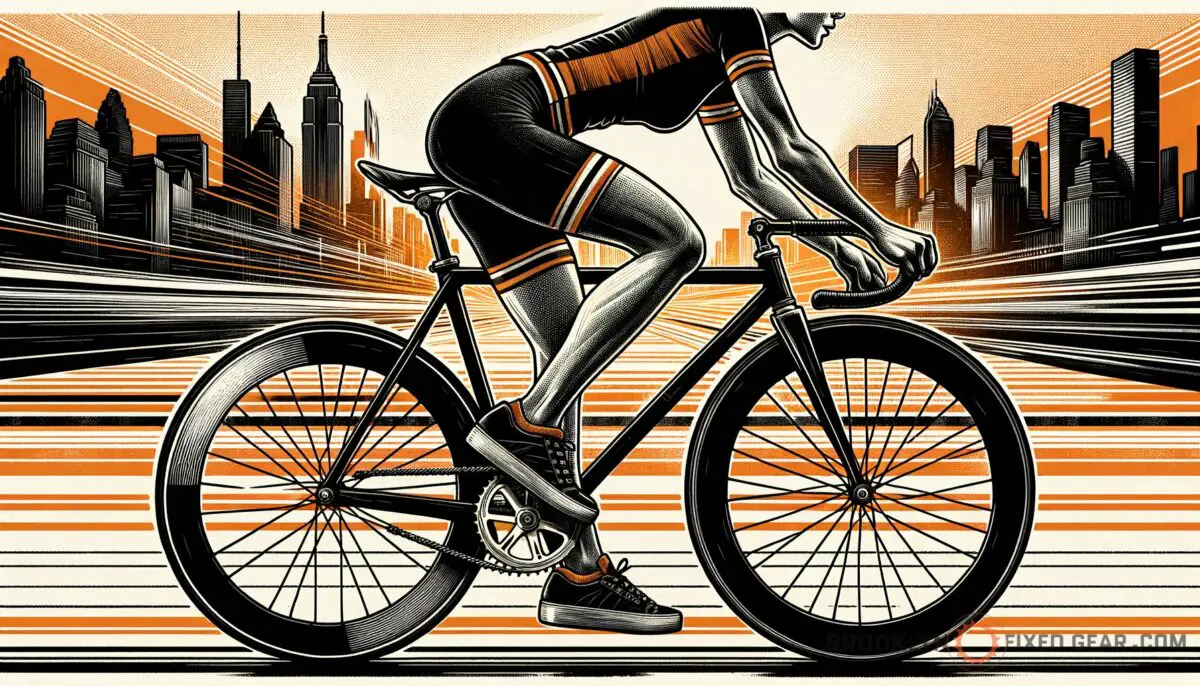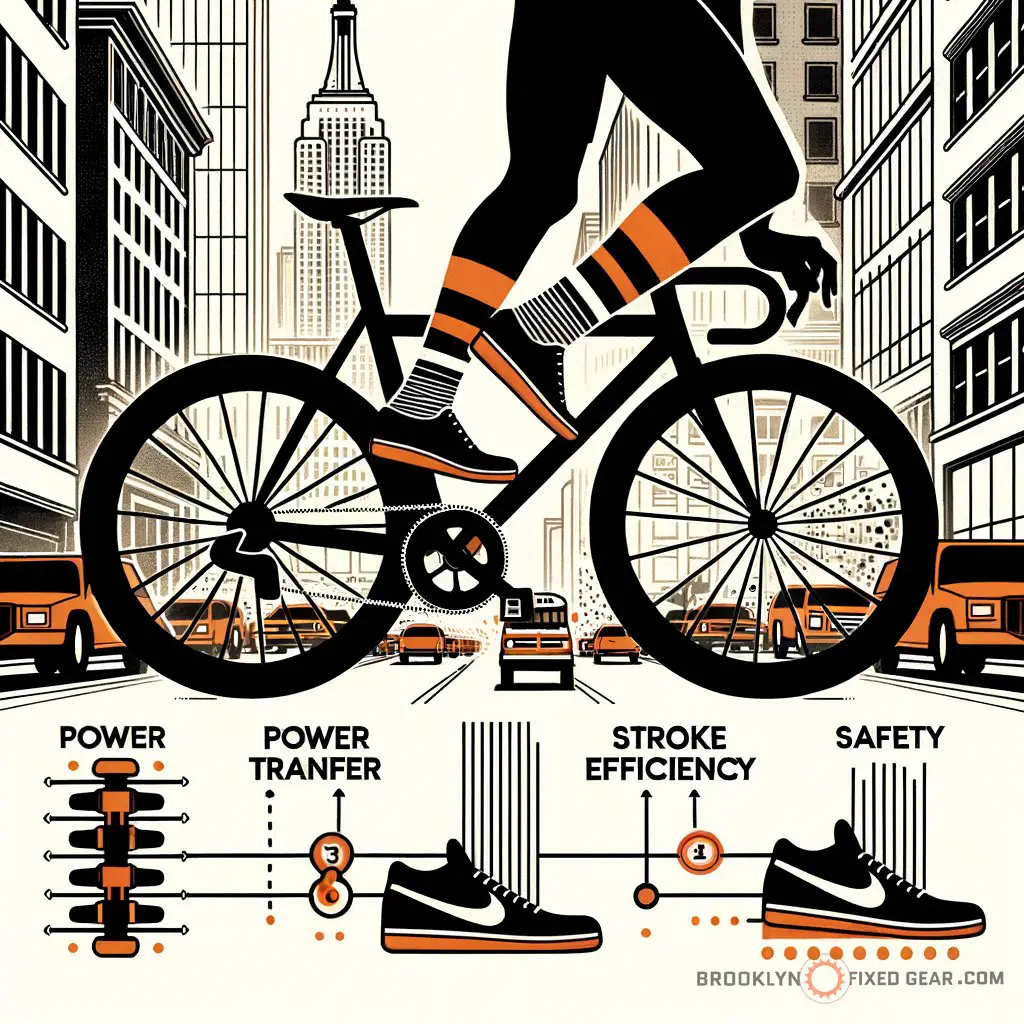Ever wondered why track cyclists keep their feet attached to the pedals? Imagine you’re on a bustling New York street, weaving through traffic; having solid foot retention could make all the difference. Learn how this feature enhances your ride on even the best fixie bikes.
Key takeaways
- Foot retention is vital for effective power transfer and safety on a fixie.
- Maintenance and proper setup are key to maximizing the benefits of foot retention systems.
- Regularly practicing engagement and disengagement is essential, especially for urban cycling.
What is foot retention in cycling?
Let’s talk about keeping those feet in check. Foot retention is all about the connection between your sneakers and your bike’s pedals. It’s crucial for us fixie enthusiasts because it gives us control, especially when you’re talking about the stop-and-go of city cycling or the precision needed on a velodrome.

So why do you need foot retention? Here’s a quick rundown:
- Power transfer: It maximizes the force you can put into each pedal stroke.
- Stroke efficiency: You’ll be pulling up on the pedals, not just pushing down.
- Safety: It keeps your feet from slipping off, which is a big no-no when you’re zipping through traffic or hitting top speeds on a track.
To get into the nitty-gritty, you’ve got a few ways to lock in those feet. You could go with toe clips and straps, holdfast straps, or my personal favorite, the clipless pedal system. If you’re setting up your bike for the first time, be sure to avoid common mistakes made when building a fixie.
For those worried about getting stuck, most systems are designed for a quick release, so with a little practice, you’ll be clipping in and out like a pro.
I’ll be straight with you, as a guy who’s all about that single-speed life, the importance of foot retention can’t be overstated. When you’re cutting through traffic, the last thing you want is a foot slipping off. It’s about that seamless flow, like you and the bike are just one piece cruising down the road.
I heard this story once about a messenger darting through the city. Without solid foot retention, his foot slipped off in the middle of a hectic intersection – total wipeout. It’s like that intense chase scene in a thriller, heart-pumping, adrenaline-charged – foot retention is what keeps that from turning into a face-plant moment.
Imagine the scene from “Premium Rush,” where Joseph Gordon-Levitt is tearing through the city, dodging cars, and taking names. He needs that connection to his bike to stay upright and fast. That’s what you can expect from proper foot retention, and for added insight, check out what dropout spacing means for your fixie what is dropout spacing.
State Bicycle Co. Black Label 6061

State Bicycle Co. Black Label 6061
Importance of foot retention
Foot retention systems are a key component for any serious cyclist, especially on a fixie. By securely attaching your foot to the pedal, you get a full range of motion.
What types of foot retention exist?
Toe clips, straps, and clipless systems are the primary types. Each type provides varying levels of security and efficiency. Learn the pros and cons to choose the right one for your cycling needs.

- Clipless pedals offer a secure attachment and superior power transfer.
- Toe clips and straps are a more traditional option that can be easier to adjust on the fly.
Learn more about the differences between pedal types and what suits your fixie here.
How does foot retention affect performance?
Good foot retention enhances your cycling performance by improving your pedaling efficiency and bike control.
- Riders can maintain a consistent rhythm.
- It reduces the risk of foot slippage during critical maneuvers.
For an in-depth take on performance gear, explore the nuances of what is Dura-Ace in the context of cycling.
Choosing the right foot retention
Finding the right setup requires you to match the foot retention system to your riding style.
Considerations for track bikes
Track bikes demand maximum performance. Choosing-a foot-retention system that delivers performance without compromising safety is crucial.
- Consider the rigors of track racing when selecting.
- Ensure quick release in case of emergency.
Considerations for urban cycling
Urban cyclists need a balance of performance and practicality. Their choice should reflect the need for quick engagement and release in traffic.
- Look for a system that balances efficiency with ease of use.
- Frequent stops require a retention system that’s easy to disengage.
For tips on setting up your bike, read about the best bike multi-tools available.
Maintenance and adjustment
Like any other part of your bike, foot retention systems require regular maintenance.
How to maintain your foot retention system
Regular checks and adjustments can prolong the life of your foot retention system.
- Clean and inspect for wear regularly.
- Adjust to ensure snug fit and quick release as needed.
Troubleshooting common issues
Sometimes things go wrong. Knowing how to fix common issues can save you from a long walk home.
- Straps and clips can loosen over time and may require adjustment.
- Clipless systems may require tension adjustments and cleat replacement.
For more on bike maintenance, check out our guide on what does electronic shifting mean.
Safety considerations with foot retention
Safety is always a top priority when cycling, especially in busy environments.
Risks associated with foot retention
Being attached to your bike can pose risks in certain situations.
- The need for quick disengagement in emergencies.
- The potential for accidents if release mechanisms fail.
Ensure you’re prepared by understanding the importance of what is ergonomics in cycling.

Tips for safe use
Use foot retention safely to avoid unwanted incidents.
- Start with lower tension settings and practice disengaging frequently.
- Double-check your system before each ride to ensure proper function.
For further reading on safety, learn about what is an endo in cycling.
Leading paragraph: This data table summarizes the key aspects of different foot retention systems and their suitability for fixed-gear bicycles. It’s designed to help you quickly compare types based on performance, safety, and ease of use.
| Foot Retention Type | Performance | Safety | Ease of Use |
|---|---|---|---|
| Clipless Pedals | High | Medium | Low |
| Toe Clips & Straps | Medium | High | Medium |
| Holdfast Straps | Low | Low | High |
“Navigating the ins and outs of foot retention can be like threading your chain through a tight cog – a bit tricky, but it’ll smooth out your ride once you’ve got it dialed in.”
Navigating the ins and outs of foot retention can be like threading your chain through a tight cog – a bit tricky, but it’ll smooth out your ride once you’ve got it dialed in. Here’s a table to guide you through the do’s and don’ts when it comes to foot retention.
| Do | Don’t |
|---|---|
| Do practice clipping in and out. | Don’t neglect regular maintenance. |
| Do ensure proper fit for your shoes. | Don’t ignore discomfort in your feet. |
| Do adjust tension settings as needed. | Don’t forget to check for wear. |
More cycling tips
Riding a fixie isn’t just about pushing pedals; it’s about finesse, style, and knowing your gear inside-out. When it comes to improving your cycling experience and safety, these tidbits may just give you the edge.
- Always wear a helmet, no matter how short the journey.
- Keep an eye on your tire pressure to ensure optimal performance and comfort.
- Use lights and reflective gear for those late-night rides or early morning commutes.
- Carry a basic bike multi-tool for on-the-go adjustments and repairs.
- Master the art of hand signals for better communication with other road users.
- If you’re a frequent rider, consider ergonomic upgrades to your saddle and grips for added comfort. Check the options for choosing a bike saddle.
- Keep up with regular maintenance – a well-oiled chain and properly adjusted brakes make a world of difference.
- Learn how to skid stop efficiently – it’s an essential skill for fixed-gear riders and a real knee-saver.
- Stay hydrated, especially on longer rides or scorching summer days. A bottle cage is a fixie-friendly option to keep water within reach.
- And finally, keep up with local cycling laws and etiquette to stay safe and respectful on the road.
If you are a visual learner, check out this video titled ‘Clipless Pedals vs. Toe Clips vs. Straps | Which Fixed Gear Pedals are Best for YOU?’
Frequently asked questions (FAQ)
Can you ride a fixed-gear bike without foot retention?
Yes, you can ride a fixed-gear bike without foot retention, but it’s not recommended. Foot retention provides better control of the bike, allows for efficient energy transfer, and helps prevent your feet from slipping off the pedals, which is especially critical when braking with pedal resistance.
How usually should you replace your foot retention system?
The lifespan of your foot retention system varies based on usage and the type of system you have. Generally, you should inspect them regularly for signs of wear and replace them once they show significant wear or if the retention mechanism doesn’t function smoothly anymore.
Are there foot retention options for cyclists with larger feet?
Absolutely, cyclists with larger feet can find foot retention systems designed to accommodate their size. Many straps and clips come in adjustable sizes, and most clipless pedal systems offer a range of cleat adjustments to fit various shoe sizes comfortably.
Final thoughts
In the whirl of gears and wheels that define the urban cycling landscape, foot retention stands out as a key element that merges safety with high performance. Whether you’re zipping around the city or hitting the track, understanding and utilizing proper foot retention can dramatically uplift your riding experience. Remember, it’s not just about being attached to your bike; it’s about the harmony of movement that can only come from the perfect cyclist-pedal connection.
How has foot retention changed the way you cycle? Did I cover everything you wanted to know? Let me know in the comments section below. I read and reply to every comment. If you found this article helpful, share it with a friend, and check out my full blog for more tips and tricks on fixed-gear cycling.
Thanks for reading and keep rolling with confidence!















